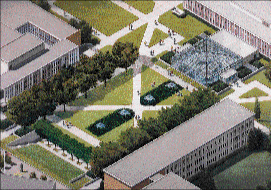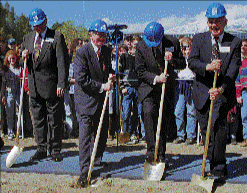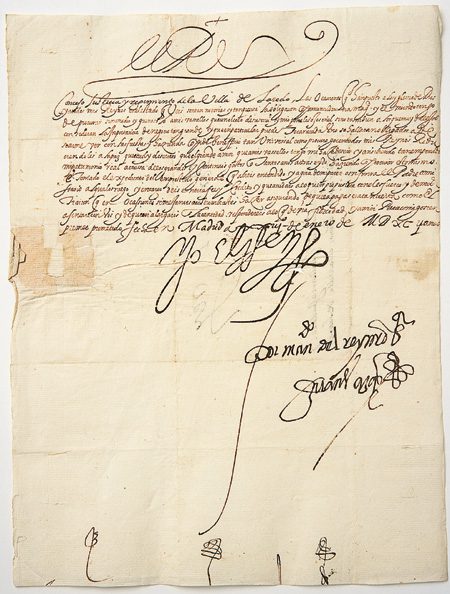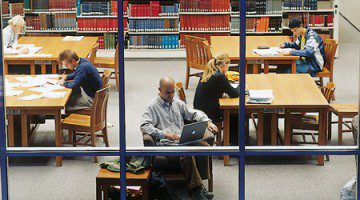By Karen Snow
 A great library is the heart of a university,” said LDS Church President Gordon B. Hinckley to the crowd of students, faculty members, and guests gathered for the groundbreaking ceremony of the Harold B. Lee Library expansion.
A great library is the heart of a university,” said LDS Church President Gordon B. Hinckley to the crowd of students, faculty members, and guests gathered for the groundbreaking ceremony of the Harold B. Lee Library expansion.
Presidents Thomas S. Monson and James E. Faust of the First Presidency and BYU President Merrill J. Bateman joined President Hinckley in officiating at the ceremony held Sept. 20 in the quad area north of the library.
The ceremony marked the beginning of a three-floor, 235,000 square-foot underground addition to the library that will require the largest excavation in BYU’s history. The project also includes renovations to the existing library and is designed to provide more study space, additional shelving, controlled environmental conditions for preserving valuable research materials, and an infrastructure for the electronic library of the 21st century.
The all-underground L-shaped addition will expand 442 feet north beneath the quad to the Abraham O. Smoot Administration Building and 285 feet east toward the Wilkinson Center. A glass-enclosed atrium, the most visible landmark of the expansion, will serve as the new and only entrance to the completed library due to renovations to be made on the south side of the building. Four large skylights to be placed in the restored quad between the Smoot Building and the atrium will provide natural light to the level below, the second floor.
One of the exciting features of the addition, says deputy university librarian Randy Olsen, will be the wiring of all study tables to allow students to connect laptop computers to the Internet and to university networks. “From almost anywhere in the building, students will be able to sit down and plug into the Internet.”
Included in the expansion are four Technology Enhanced Learning Environment classrooms and one 200-seat auditorium. The auditorium and the classrooms, Olsen says, will be equipped for distance education, both broadcasting and receiving. “Our electronic classrooms will be among the most advanced in the nation.”
Olsen says the addition will also house three large, open labs with a total of more than 300 computers. A fourth computer lab will be dedicated to an expanded family history library located on the second floor.
The first floor, or lower level, will house Special Collections, which will feature environmentally controlled storage areas for the long-term preservation of valuable research materials. “BYU will have one of the finest facilities for Special Collections in the country,” says Olsen.
The addition will also provide increased seating capacity for students. Olsen says seating capacity has been one of the library’s biggest problems. “Right now we can seat only about 14 percent of the student body in the library. The addition will add another 1,300 seats–more than enough for the students who have wanted to come to the library to study but haven’t been able to.”
In addition to running out of space for students, the library ran out of space for books, says Olsen. “We have over 250,000 books now shelved off campus in a facility that used to be a grocery store. It’s hardly an ideal environment for library materials.” Olsen says the library adds about 50,000 new books every year and subscribes to approximately 18,000 journals. “We simply need more space to house our existing collections and to provide for future growth.”
The renovations to the existing library will upgrade outdated mechanical and electrical systems and will include the addition of a music library on the fourth floor, 41 new faculty offices on the ground level, and a technology-enhanced Center for Students with Disabilities. In addition, the management library will be relocated from the Tanner Building to the Harold B. Lee Library.
The expansion is scheduled to be completed in December 1998; however, the remodeling of the existing building will continue through December 1999.

President Thomas S. Monson, President Gordon B. Hinckley, President James E. Faust, and Elder Dallin H. Oaks break ground for the 235,000 square-foot underground addition to the Harold B. Lee Library
The scale of the library renovation and expansion is daunting. Mike Stratton, director of construction at BYU, says the earth removal necessary for the three-story hole will require one truckload of dirt to leave the site every five minutes for 204 days.
At the groundbreaking, President Hinckley marveled at the size of the expansion. “This addition will be the equivalent of 10 large stake centers. And I’d like to just add that it will cost more than 10 good stake centers.”
The expansion is being funded through private donations, President Hinckley said. No tithing money will be used in the project.
“There is something sacred about a great library,” he said, “because it represents the preservation of the wisdom, the learning, the ponderings of all men and women of all of the ages accumulated together under one roof to which we can have access as our needs require.”
President Faust remarked, “This library will become literally a library to the world, whereby members of the Church and others can access the vast store of information and knowledge which will be here.”
President Bateman agreed. “Eventually, I see this library as a centerpiece of learning that can service people well beyond this campus.”
President Monson gave tribute to the library’s namesake, former Church President Harold B. Lee, saying, “We couldn’t do less for a man who gave so much.”









